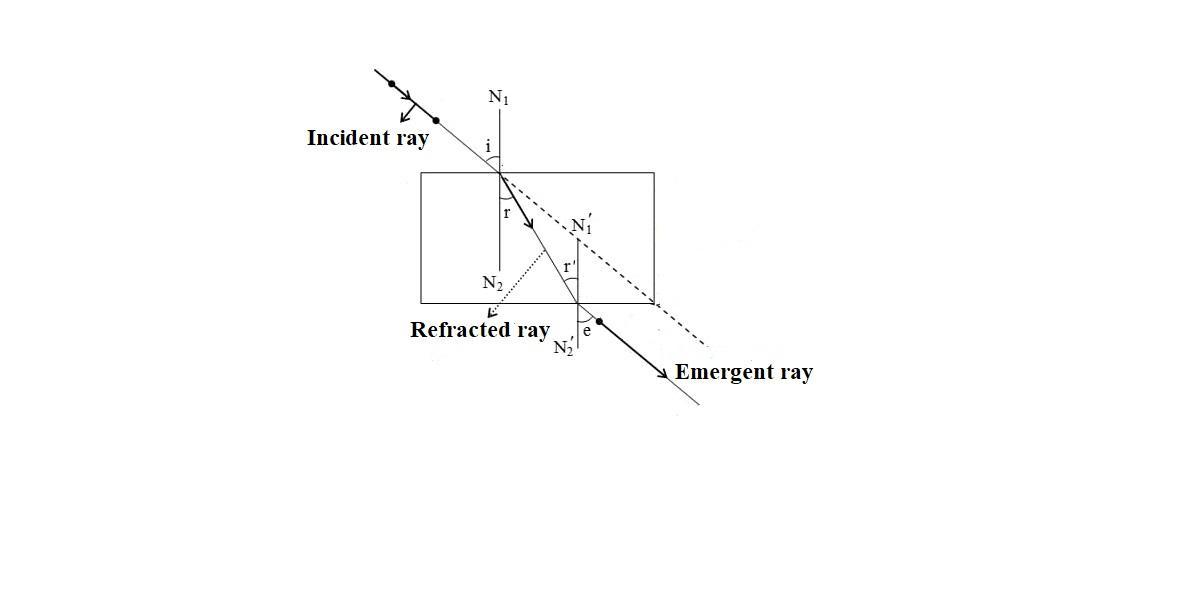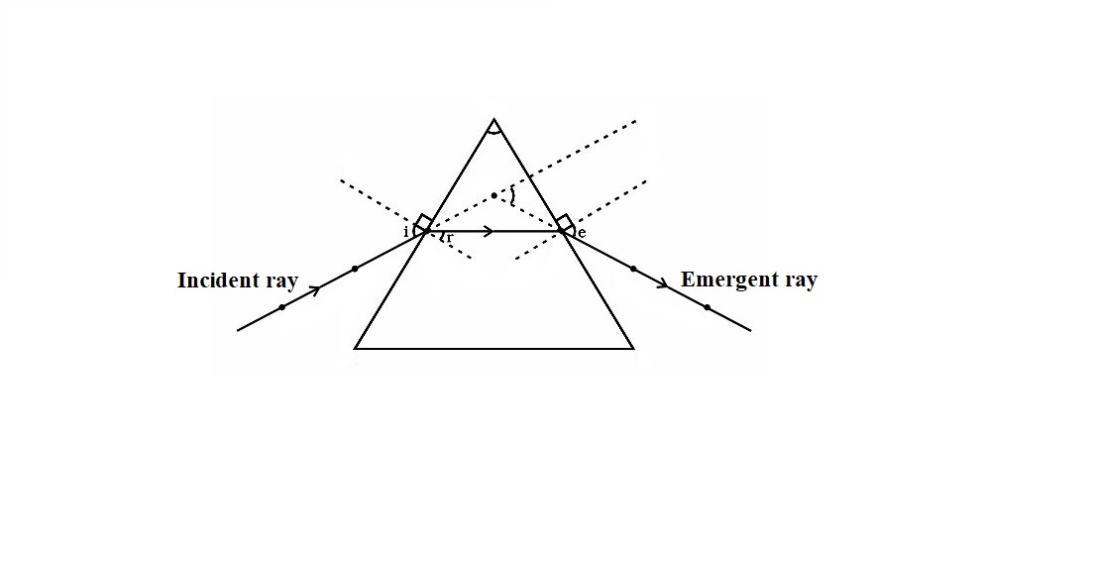
How is the angle of emergence $'e'$ related to the angle of incidence $'i'$?
Answer
510.9k+ views
Hint: For different mediums, when a ray of light undergoes refraction, there is some relation between the angle of incidence and the angle of emergence. We will consider two mediums glass slab and glass prism and will find the relation between angle of emergence $'e'$ and angle of incidence $'i'$.
Complete step by step answer:
In case of a glass slab, the incident ray is parallel to the emergent ray. It means that the angle of incidence is equal to the angle of emergence.

When a ray of light is incident on the surface of a glass slab, it undergoes refraction. As the glass slab is a denser medium and has a higher refractive index than air, the ray of light bends towards the normal. The same ray of light which is refracted acts as the incident ray on the inner surface of the glass slab. It undergoes refraction again and comes out of the glass slab as an emergent ray. This time the ray bends away from the normal. As the ratio of refractive indices of air and the glass slab remains the same in both cases (though their value gets inverted), the emergent ray is parallel to the incident ray.
Therefore, angle of emergence $'e'$ is equal to the angle of incidence $'i'$.
In case of a prism,

When a ray of light is incident on the surface of a glass prism, it undergoes refraction. Since the refraction takes place from air to glass, the ray of light will bend towards the normal. The refracted ray is incident on the other surface of the prism. This time the refracted ray bends away from the normal.
$\delta =i+e-A$
$\delta $ is the Angle of deviation
$i$ is the angle of incidence
$e$ is the angle of emergence
$A$ is the angle of prism
When a ray of light suffers minimum deviation through prism, angle of incidence is equal to the angle of emergence. Ray of light passing through the prism will be parallel to the base of the prism. Angle of refraction inside the material of the prism is half the angle of the prism.
Note: Students should keep in mind that in case of a glass slab, angle of emergence is always equal to the angle of the incidence. But in case of glass prism, angle of emergence is equal to angle of incidence at the minimum deviation only.
Complete step by step answer:
In case of a glass slab, the incident ray is parallel to the emergent ray. It means that the angle of incidence is equal to the angle of emergence.

When a ray of light is incident on the surface of a glass slab, it undergoes refraction. As the glass slab is a denser medium and has a higher refractive index than air, the ray of light bends towards the normal. The same ray of light which is refracted acts as the incident ray on the inner surface of the glass slab. It undergoes refraction again and comes out of the glass slab as an emergent ray. This time the ray bends away from the normal. As the ratio of refractive indices of air and the glass slab remains the same in both cases (though their value gets inverted), the emergent ray is parallel to the incident ray.
Therefore, angle of emergence $'e'$ is equal to the angle of incidence $'i'$.
In case of a prism,

When a ray of light is incident on the surface of a glass prism, it undergoes refraction. Since the refraction takes place from air to glass, the ray of light will bend towards the normal. The refracted ray is incident on the other surface of the prism. This time the refracted ray bends away from the normal.
$\delta =i+e-A$
$\delta $ is the Angle of deviation
$i$ is the angle of incidence
$e$ is the angle of emergence
$A$ is the angle of prism
When a ray of light suffers minimum deviation through prism, angle of incidence is equal to the angle of emergence. Ray of light passing through the prism will be parallel to the base of the prism. Angle of refraction inside the material of the prism is half the angle of the prism.
Note: Students should keep in mind that in case of a glass slab, angle of emergence is always equal to the angle of the incidence. But in case of glass prism, angle of emergence is equal to angle of incidence at the minimum deviation only.
Recently Updated Pages
Master Class 12 English: Engaging Questions & Answers for Success

Master Class 12 Economics: Engaging Questions & Answers for Success

Master Class 12 Social Science: Engaging Questions & Answers for Success

Master Class 12 Maths: Engaging Questions & Answers for Success

Master Class 12 Chemistry: Engaging Questions & Answers for Success

Master Class 12 Business Studies: Engaging Questions & Answers for Success

Trending doubts
What are the major means of transport Explain each class 12 social science CBSE

Which are the Top 10 Largest Countries of the World?

Draw a labelled sketch of the human eye class 12 physics CBSE

Explain sex determination in humans with line diag class 12 biology CBSE

The pH of the pancreatic juice is A 64 B 86 C 120 D class 12 biology CBSE

Explain sex determination in humans with the help of class 12 biology CBSE




